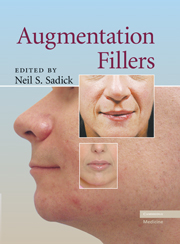Book contents
- Frontmatter
- Contents
- LIST OF CONTRIBUTORS
- Ch. 1 Application of Fillers
- Ch. 2 Approach to Choosing the Ideal Filler
- Ch. 3 Patient Selection, Counseling, and Informed Consent
- Ch. 4 Hyaluronic Acid Skin Derivatives
- Ch. 5 Collagen Products
- Ch. 6 Radiesse
- Ch. 7 ArteFill
- Ch. 8 Augmentation Fillers in Cosmetic Dermatology: Silicone
- Ch. 9 Advanta Expanded Polytetrafluoroethylene Implants
- Ch. 10 Sculptra
- Ch. 11 Lipo Transfer
- Ch. 12 BioAlcamid®
- Ch. 13 Combination of Approaches in Augmentation Fillers in Cosmetic Dermatology
- Ch. 14 Filling Complications
- Ch. 15 Postprocedure Management and Patient Instructions
- Ch. 16 Conclusion: Future Trends in Fillers
- INDEX
- References
Ch. 14 - Filling Complications
Published online by Cambridge University Press: 26 February 2010
- Frontmatter
- Contents
- LIST OF CONTRIBUTORS
- Ch. 1 Application of Fillers
- Ch. 2 Approach to Choosing the Ideal Filler
- Ch. 3 Patient Selection, Counseling, and Informed Consent
- Ch. 4 Hyaluronic Acid Skin Derivatives
- Ch. 5 Collagen Products
- Ch. 6 Radiesse
- Ch. 7 ArteFill
- Ch. 8 Augmentation Fillers in Cosmetic Dermatology: Silicone
- Ch. 9 Advanta Expanded Polytetrafluoroethylene Implants
- Ch. 10 Sculptra
- Ch. 11 Lipo Transfer
- Ch. 12 BioAlcamid®
- Ch. 13 Combination of Approaches in Augmentation Fillers in Cosmetic Dermatology
- Ch. 14 Filling Complications
- Ch. 15 Postprocedure Management and Patient Instructions
- Ch. 16 Conclusion: Future Trends in Fillers
- INDEX
- References
Summary
INTRODUCTION
Slowing down the inevitable course of skin aging has been a popular notion for hundreds of years. Ancient Egyptians compounded early chemical peels using the lactic acid in milk and performed an early form of microdermabrasion with salt, alabaster, and animal oils. More sophisticated methods including soft tissue augmentation with autologous fat were first reported in the German literature by Neuber in 1893.
The first U.S. Food and Drug Administration (FDA)–approved filler was bovine collagen (Zyderm I) in 1981. Since then, a myriad of soft tissue fillers have been introduced. These include both bovine and human collagens (Zyderm, Zyplast, CosmoDerm, and CosmoPlast), hyaluronic acids (Restylane, Perlane, Juvederm, and Hylaform), calcium hydroxyapatite (Radiesse), poly-l-lactic acid (Sculptra), and synthetic polymers such as liquid silicone and Artecoll or Artefill. These procedures have gained popularity as they are generally safe in experienced hands, and many show rapid improvement yielding high levels of clinical satisfaction.
All cosmetic procedures have associated risks. As the incidence of soft tissue augmentation has increased, as would be expected, adverse effects have been reported more commonly. In a survey of 286 patients, McCraken et al. recently reported a 5 percent complication rate among ophthalmologists performing soft tissue augmentation procedures. This article will emphasize the prevention, identification, and treatment complications with a focus on temporary fillers. Permanent fillers (such as Artecoll) permit greater longevity with which comes the greater risk of adverse sequelae. These permanent substances present a greater risk of causing late-onset (>one year) granulomas.
- Type
- Chapter
- Information
- Augmentation Fillers , pp. 129 - 136Publisher: Cambridge University PressPrint publication year: 2010
References
- 1
- Cited by



